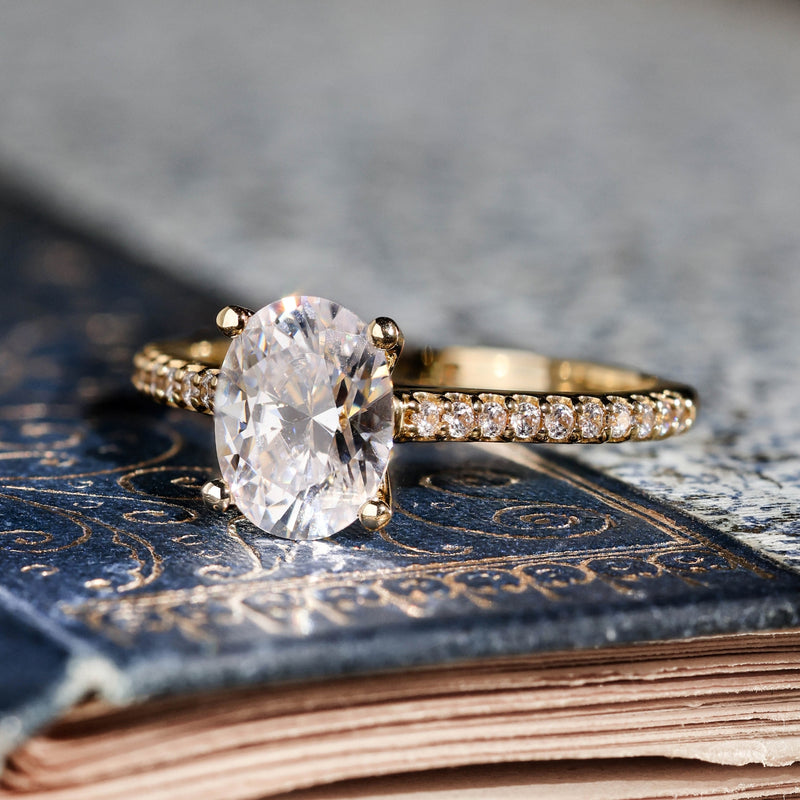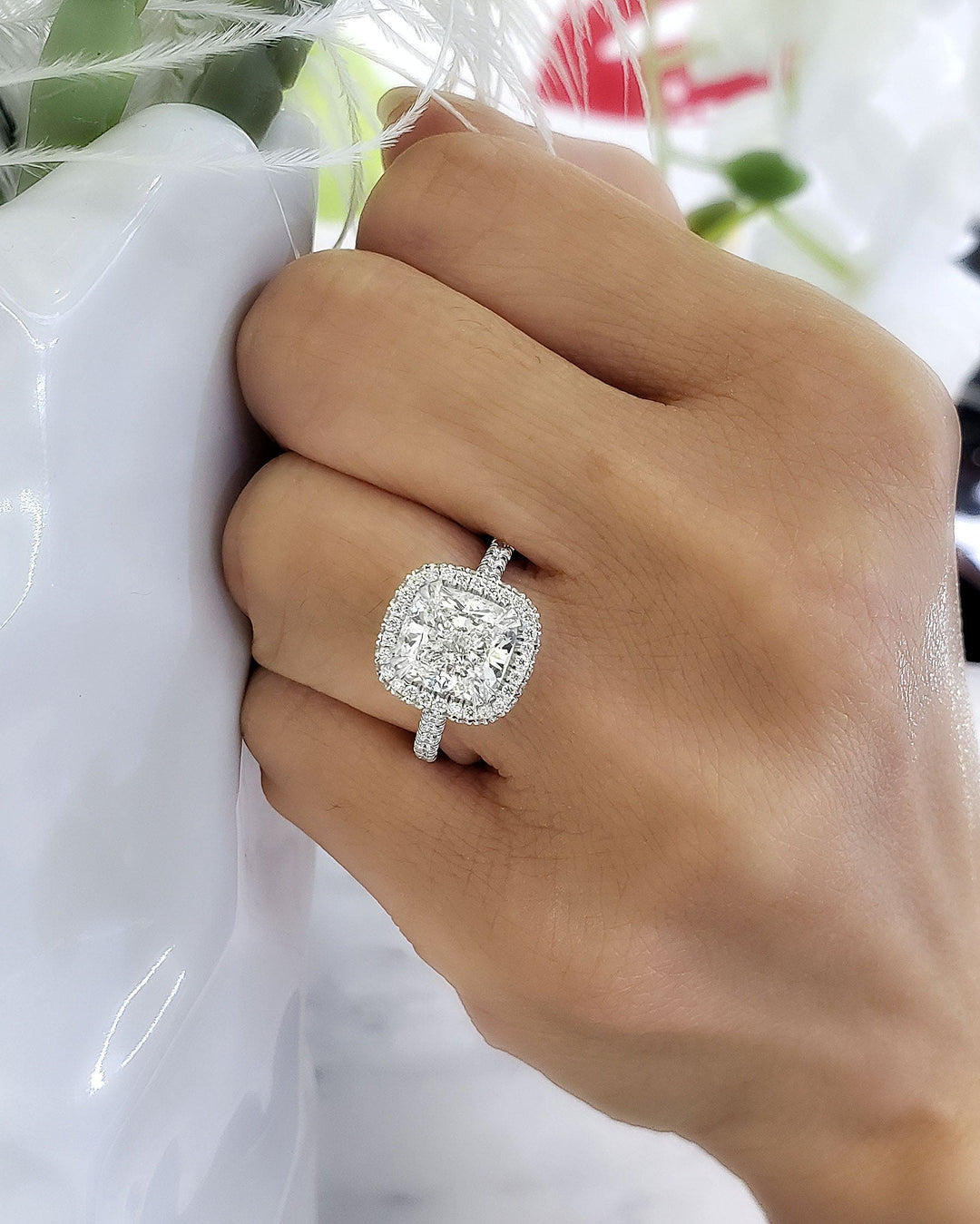How to Choose the Best Cut for lab grown diamond engagement rings
Wiki Article
The Benefits of Picking Lab Grown Diamond Interaction Rings for Your Proposition
Lab-grown Diamond interaction rings provide a compelling alternative for pairs considering their proposal alternatives. These rubies are ethically sourced and developed in controlled settings, dealing with both moral and ecological concerns. Additionally, they use significant expense financial savings, enabling larger stones or one-of-a-kind styles. With advancements in modern technology, the appeal of lab-grown rubies continues to grow. Recognizing these benefits can affect a couple's decision-making process in profound means. What factors should be prioritized when making this choice?Honest Sourcing and Environmental Effect
As consumers increasingly focus on sustainability, the rise of lab-grown Diamond involvement rings provides a compelling option to generally extracted diamonds. These lab-created treasures are created in controlled settings, considerably lowering the ethical issues related to Diamond mining. Typical mining typically entails exploitative labor practices and adds to environmental deterioration, consisting of logging and habitat damage.
Cost-Effectiveness: Even More Worth for Your Budget plan
Lab-grown Diamond engagement rings not just straighten with honest worths yet likewise offer significant price benefits. Usually, these rubies can be priced 20% to 40% less than their extracted equivalents, allowing pairs to optimize their budget plans without sacrificing quality. This cost-effectiveness makes it possible for buyers to purchase bigger stones or higher-quality setups, improving the overall aesthetic of the ring.Additionally, the transparency in pricing connected with lab-grown rubies gets rid of the covert prices usually associated with mined rubies, such as certification and transport costs. Couples can also take advantage of lower insurance policy premiums due to the reduced value of lab-grown diamonds.
As a result, picking a lab-grown Diamond interaction ring ends up being a financially smart decision, providing pairs with more worth for their money. This affordability not just enables a better option but additionally equips pairs to choose a ring that genuinely mirrors their love and dedication.
Identical Physical and Chemical Characteristics
The appeal of lab-grown Diamond interaction rings lies not only in their moral production however additionally in their amazing physical and chemical residential or commercial properties. These rubies are developed in controlled lab environments that imitate the all-natural problems under which rubies create in the Earth. Because of this, lab-grown diamonds have the same crystal structure and firmness as their extracted equivalents, ranking a perfect 10 on the Mohs scale.Both types of rubies contain carbon atoms set up in a crystal lattice, making sure the same optical and physical traits. Lab-grown diamonds exhibit the same brilliance, fire, and scintillation as all-natural rubies, making them tantamount to the nude eye. Advanced gemological screening is required to differentiate in between both, underscoring their authenticity. This parity in residential properties permits customers to appreciate the elegance and longevity of rubies while making an environmentally mindful option.
Broader Range of Choices
Laboratory produced Diamond involvement rings supply a more comprehensive variety of layout choices that cater to diverse tastes and choices. Their capability to be personalized allows couples to develop one-of-a-kind items that show their individual design. This boosted versatility not only boosts the ring's nostalgic value but also makes it an extra individual option.Distinct Design Choices
While standard diamonds often feature restricted design options, the surge of lab-grown Diamond engagement rings has actually opened up a more comprehensive range of one-of-a-kind designs and settings. This development permits pairs to check out more creative designs, varying from vintage-inspired to contemporary geometric shapes. Lab-grown rubies can be crafted in various cuts, consisting of oval, pear, and heart forms, offering versatility that attract varied preferences. Furthermore, the capacity to combine these rubies with unique band materials, such as rose gold or fairly sourced steels, improves the total visual. With distinct settings like halo or bezel, these rings can be individualized to show specific tales and preferences, making each interaction ring not simply a sign of love, yet also a standout item of art.Modification Possibilities
An expanding rate of interest in lab-grown Diamond interaction rings has actually resulted in a rise in customization possibilities, permitting couples to produce truly customized items. Unlike traditional diamonds, lab-grown choices can be customized to fit private tastes and choices. Pairs can pick from a bigger variety of colors, forms, and dimensions, enabling them to select a ruby that reverberates with their unique style. Furthermore, modification expands past the Diamond itself; settings can be developed to enhance the picked rock, whether one favors classic, modern, or elaborate styles. This versatility not only improves the psychological value of the ring yet additionally permits a more budget-friendly approach, as pairs can focus on attributes that matter most to them without compromising on top quality.Openness in the Diamond Sector
Exactly how can customers navigate the complexities of the Diamond industry when transparency continues to be a crucial issue? The conventional Diamond market often lacks clear details concerning the origin and ethical sourcing of rubies. This obscurity can cause consumer mistrust and ethical problems surrounding problem rubies and environmental impact. Conversely, laboratory grown diamonds use a remedy to this transparency issue. These rubies are produced in controlled settings, permitting consumers to accessibility thorough details about their provenance.Moreover, reliable sellers of laboratory grown diamonds usually supply certificates that describe the information of the Diamond's production, including its dimension, high quality, and the technology made use of. This level of transparency encourages consumers to make informed selections, straightening their acquisitions with personal worths. As awareness of dishonest techniques in the Diamond sector expands, the clear, ethical nature of laboratory expanded diamonds placements them as a compelling option for diligent consumers seeking involvement rings.
Supporting Technology and Innovation
As the need for ethically sourced gemstones boosts, sustaining innovation and technology in the lab-grown Diamond field becomes crucial (lab grown diamond engagement rings). Lab-grown diamonds, produced with innovative methods such as High Pressure Heat (HPHT) and Chemical Vapor Deposition (CVD), stand for a substantial shift in the Diamond market. Buying these modern technologies not only enhances the high quality and availability of rubies yet also minimizes ecological influence contrasted to typical mining practicesFurthermore, developments in manufacturing strategies have actually brought about more efficient processes, resulting in reduced costs for consumers. This technological development promotes competition, compelling traditional Diamond manufacturers to reevaluate their methods and adopt more sustainable techniques. By sustaining lab-grown diamonds, consumers add to a market that focuses on moral sourcing and innovation, eventually advertising a more liable and ecologically conscious precious jewelry market. Accepting this new era not only benefits customers yet likewise urges continued advancements in gemstone production modern technologies.

Customization and Modification Choices
Laboratory grown Diamond involvement rings offer an array of personalization and personalization options that satisfy individual choices. Consumers can choose unique style options and tailored stone characteristics, making sure that each ring shows individual style and importance. This capability to customize boosts the emotional value of the ring, making it a meaningful sign of commitment.Unique Design Options
What makes a ruby engagement ring absolutely special? Its unique style wikipedia reference selections permit deep personalization, showing the pair's distinctive love story. Lab produced diamonds provide a range of alternatives, from various cuts and setups to custom engravings. Couples can choose from classic jewelry to detailed halo layouts, guaranteeing their ring lines up with individual tastes. Additionally, the adaptability of laboratory grown diamonds allows the incorporation of tinted gemstones, such as sapphires or emerald greens, improving uniqueness. Personalization encompasses the metal selection, whether it's white gold, yellow gold, or rose gold. This flexibility in design not only develops an one-of-a-kind item yet additionally embodies the couple's commitment, making the engagement ring a remarkable sign of their distinct trip with each other.Tailored Rock Characteristics
When considering the attributes of a diamond interaction ring, pairs locate that tailored rock alternatives substantially boost the customization process. Lab-grown diamonds offer an array of personalized attributes, allowing couples to choose the size, form, and shade that best mirrors their one-of-a-kind style and preferences. This flexibility makes it possible for individuals to produce a ring that represents their romance. Additionally, couples can select certain clarity levels and cut styles, ensuring that the Diamond not only fulfills their aesthetic needs but likewise fits their spending plan. With lab-grown rubies, the chance for modification includes setting kinds and metal choices, additionally improving the ring's uniqueness. Ultimately, tailored rock features equip couples to make a purposeful involvement ring that truly represents their relationship.Regularly Asked Questions
How Do Laboratory Grown Diamonds Compare to All-natural Rubies in Regards To Resilience?
Lab grown diamonds and all-natural diamonds display similar sturdiness, as both are made up of carbon and share equivalent hardness levels. This makes them similarly immune to scratching and damage, ensuring longevity in any precious jewelry setup.Can Laboratory Grown Diamonds Be Marketed or Appraised Like All-natural Diamonds?
Lab grown rubies can indeed be marketed and appraised in a similar way to all-natural rubies. Their resale value might vary due to market perceptions and the growing accessibility of lab-created choices in the precious jewelry sector.What Is the Distinction in Shimmer Between Lab Grown and Natural Diamonds?

Do Lab Grown Diamonds Feature Certifications Like All-natural Diamonds?
Laboratory grown rubies do include qualifications, comparable to all-natural diamonds. These accreditations verify their top quality, including factors like cut, quality, carat, and shade weight, making sure customers get a trustworthy assessment of their acquisition.Just How Are Lab Grown Diamonds Made to begin with?
Lab expanded rubies are developed via 2 primary approaches: High Pressure Heat (HPHT) simulates all-natural procedures, while Chemical Vapor Deposition (CVD) makes use of gases to down payment carbon, enabling controlled Diamond development in a laboratory atmosphere. lab grown diamond engagement rings.As consumers increasingly prioritize sustainability, the increase of lab-grown Diamond engagement rings offers an engaging alternative to typically mined rubies. In addition, the transparency in rates associated with pop over to this site lab-grown rubies removes the covert expenses commonly associated with extracted diamonds, such as certification and transport costs. Lab-grown diamonds show the same luster, fire, and scintillation as all-natural rubies, making them indistinguishable to the nude eye. While traditional diamonds typically come with limited layout options, the rise of lab-grown Diamond interaction rings has opened up a more comprehensive spectrum of special styles and setups. Lab-grown diamonds, developed via sophisticated techniques such as High Stress High Temperature Level (HPHT) and Chemical Vapor Deposition (CVD), stand for a considerable change in the Diamond market.
Report this wiki page